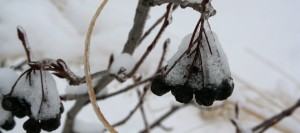Great Plants for Northern Gardens: Day 10 — Black Chokeberry

Trees and shrubs form the backbone of many gardens. Coming in a variety of sizes and often providing multiple season interest, shrubs work well in foundation plantings, perennial borders or as hedges.
For a sunny to partially shady site with wet or dry soil, one of the best of the shrubs is black chokeberry ( Aronia melanocarpa). A Minnesota native, black chokeberry grows 4 to 6 feet tall and offers year-long good looks. In spring, it puts out clusters of pretty white flowers, which will later turn to a dark blue berries. The berries persist on the plant a long time. In fall, the leaves turn a red purple that is stunning.

There seems to be some controversy about whether the berries are edible. While they are full of vitamins A and C, berries of both black and red chokeberries are bitter, especially right off the bush. (This may be where the common name chokeberry comes from.) But you can eat them and we know of folks who make syrup and jams from the berries and consider it delicious. Birds will also eat berries left on the shrub in winter.
Many local garden centers carry the cultivar ‘Autumn Magic’, which is hardy to USDA Zone 3, and can be grown in northern Minnesota. ‘Autumn Magic’ grows quickly to a mature height and spread of 4 to 6 feet. It sports white, fragrant, delicate flowers in spring, followed by dark purple berries, and the hallmark reddish leaves of fall.
While chokeberry can be grown in shadier sites, you will get more fruit in sunny locations. The plant is very easy care, requiring little pruning. It has no serious disease or pest issues and looks stunning both as a single specimen or as part of a mass planting.
What’s your favorite shrub for your northern garden?

One Comment
-
Pingback: The Parade of Spring Blooming Shrubs - Minnesota State Horticultural Society
Back to Blog